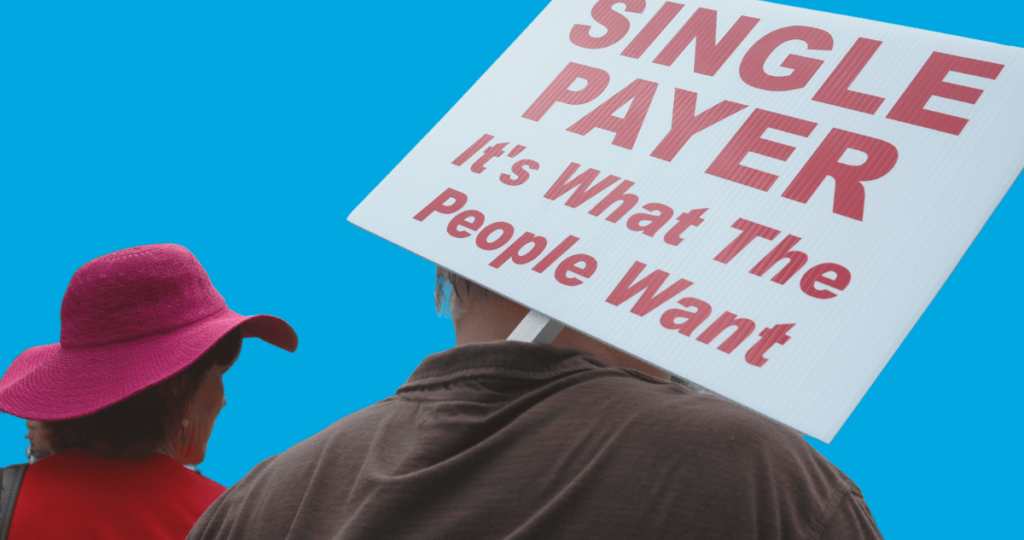Is there a way for Oregon to ensure that everyone in our state has access to affordable, quality health care? And can it be done at a lower cost compared to our current, complicated system of health care?
There is, according to a group of experts, policymakers, and community members who spent about two years looking into these questions. Created by the Oregon legislature, the Task Force on Universal Health Care has produced a blueprint for a single-payer health care system in Oregon. In this episode of Policy for the People, we speak with Dr. Bruce Goldberg, chair of the task force, about what such a system would mean for individuals and families, health providers, and employers.
Transcript
We make this transcript available for your convenience and to increase the accessibility of our content. The transcript was generated by software and was reviewed manually. We cannot guarantee that it is a perfect transcription. If you are able to, we encourage you to listen to the audio.
Juan Carlos Ordóñez (host): This past November, Oregon became the first state in the country to establish a constitutional right to health care. Voters approved Measure 111, which says, “It is the obligation of the state to ensure that every resident of Oregon has access to cost effective, clinically appropriate and affordable health care as a fundamental right.”
It will take time and court rulings to clarify what this right to health care means in practical terms. But the need for universal, appropriate and affordable health care is clear. Even after the big increase in insurance coverage following the enactment of the Affordable Care Act in 2010, some 6% of Oregonians remain uninsured. Many of those without insurance are low-paid workers, young adults, and people of color. And for those fortunate enough to have insurance, they often must navigate a complicated health care system that comes with insurance premiums, co-pays and services not covered by insurance. Health care costs can weigh heavily on families so much in some cases as to sink them into bankruptcy.
Is there a way for Oregon to ensure that everyone in our state has access to affordable, quality health care?
There is, according to a group of experts, policymakers and community members who spent about two years looking into that question. This group, the Task Force on Universal Health Care, was created by the Oregon legislature. Last fall, the Task Force on Universal Health Care issued its final report and recommendations. And a few weeks ago, the chair of that task force, Dr. Bruce Goldberg, presented the findings to a legislative committee .
On this episode of Policy for the People, we hear from Dr. Goldberg about the task force’s recommendations on its blueprint for universal health care in Oregon. Dr. Goldberg is currently a professor at the OHSU-PSU School of Public Health. He’s been the head of several administrative agencies, including serving as the founding director of the Oregon Health Authority. I should also mention that Bruce is a board member of the Oregon Center for Public Policy.
Here’s my conversation with Dr. Bruce Goldberg.
Juan Carlos: So let’s begin by setting the context. Can you give us the big picture with respect to the state of our health care system overall and the main underlying trends?
Bruce Goldberg: The short answer is it’s not very good. You know, our current health care system is financially unsustainable. Costs are increasing by amounts that no one can afford. It’s awfully complex and it’s socially unjust. You know, health care in Oregon is inequitable in how it’s delivered and paid for.
I mean, just think about it for a second. If you’re old or poor, your doctor in the hospital gets paid less for your care than if you’re well insured and wealthy. I mean, that’s just awful. And many Oregonians, because of their race, their age, their income, their insurance, endure a vastly different health care access, varied quality and wide ranging outcomes. So, you know, in summary, we just have a very unjust and complex and unsustainable system that really needs fixing.
Juan Carlos I wonder if you can say a little bit more about the complexity of the system, the fact that there are different payers into the system, different ways that money moves within the system?
Bruce: You know, it’s complex at every level. If you’re a if you’re someone who provides care within the system, you likely are contracting with 20, 30, 40 different health plans that are paying you differently, that have all different kinds of standards of care. And that complexity leads to poor outcomes. On the flip side, if you’re a consumer like me or you or everybody who’s listening, we get these explanation of benefits that says it’s not a bill, but we really don’t know what it means. It’s hard to decipher. It’s really hard to contact our our health care providers. It’s hard to know where and how to get care. And that complexity keeps us from getting care as well. So it’s complex on a more on a multiple number of layers.
Juan Carlos: So analysis by my colleagues at the Oregon Center for Public Policy shows that about 6% of Oregonians remained uninsured. And that’s a lot. But even for those who have insurance, it’s no guarantee that all is well. And I wonder if you can talk about the kinds of challenges confronting those who have health insurance.
Bruce: Yeah. You’ve you’ve hit on a really important factor that the number one cause of personal bankruptcy in our country is health care debt. And the vast majority of people who have health care debt actually have health insurance. So when you when you think about it, you know, there are a lot of people who have health insurance but may have three, four or $5,000 deductible health plans. So right off the bat, if you are a low income individual, an hourly worker trying to scrimp together to make ends meet with your family, a $5,000 health care bill can put you into bankruptcy. So it’s a real issue.
Juan Carlos: You already touched a little bit about the inequities within the system. But I’m wondering if you can say more about specifically those communities that bear the brunt of those inequities. And I’m wondering if you have seen inequities by geography, by race and ethnicity. What kind of inequities do we see?
Bruce: Well, you hit on it. It’s all those things. There’s inequities based on race and ethnicity: African-American, Latino, Native American populations have worse health outcomes than the white population. We know whether that’s higher rates of cancer, less life expectancy, see worse outcomes for diabetes, you name it. The outcomes on race and ethnicity are ubiquitous. We also see real differences in geography. A lot of our rural communities don’t have good access to health care, and as a result, they too suffer poorer outcomes, lower life expectancy, higher rates of diabetes, hypertension, less likely to survive illnesses like COVID or pneumonia. So it’s across the board — race, ethnicity, geography and income are the major places we see health disparities.
Juan Carlos: So, Bruce, you chair the Joint Task Force on Universal Health Care, and we’re going to discuss the task force’s final report and recommendations that came out not that long ago. But before we do that, can you give us some background on the task force, its mandate and how it came to be?
Bruce: The task force was set up by Senate Bill 770, which was passed a couple of years ago. That set up the the task force. The task force has 20 members: four legislators, two from the Senate, two from the House, from both parties; 13 governor appointed members; two executive branch members; and one member who represented local government. The task force was charged with putting together a single payer health care system for the state.
The task force met over the last two-and-a-half years, engaged a variety of consultants from around the country, experts. As well, we engaged the community. We had robust public engagement. We had a consumer advisory committee. We had seven roundtables with underserved communities. The groups that we just talked about, African-Americans. LatinX groups, rural communities, individuals with behavioral health needs, etc. We had six regional community listening sessions, including one that was in Spanish.
We had forums with health care professionals, hospitals and health systems, employers, both large and small and and unions. You know, we met over the last couple of years — a tremendous amount of work done by task force members. I’ve never seen a task force really so engaged and putting so much work into it. You know, there were times that task force members met, you know, for several hours each week working on problems. And the result has been a report that will we’ll talk about.
Juan Carlos: Let’s dive into that report, the findings and recommendations. And maybe I can start by asking about the bottom line. Is there a path for Oregon to create a system that provides everyone in our state affordable, quality health care?
Bruce: Well, I certainly hope so. We’ve put together a plan where all Oregonians are covered. There is a robust health care benefit, which we all have, which, quite frankly, for the vast majority of Oregonians will be better than they have today. We eliminate any deductibles, co-pay and co-insurance. We pay all providers the same no matter who you are. And in the end, this new system will cost less than our current system. So we can cover everybody, give everybody a better benefit, and do that at a price that’s less than our current system. That should be something we can do.
Juan Carlos: Just to be clear, you already mentioned the phrase single payer. But what we’re talking about here is a system where the state becomes the only entity that pays health care providers. It would take the place of all the different private health insurers. Is that the case?
Bruce: Correct. There would be a limited role for health insurers. The role for health insurers would be they would be able to provide coverage for things that are not covered by the universal health plan. The universal health plan doesn’t cover long term care, and it doesn’t cover, you know, certain cosmetic procedures and some other things like, you know, certain few medicines that most health plans today don’t cover. So those types of things would be a very limited role. And, you know, providers of care would get paid by one entity and there would be a single payment rate.
Juan Carlos Some of the ways that people in Oregon get health care right now, a significant number of people, are through public sources like Medicare and Medicaid. What would happen for those folks who get health care that way within this new system that the task force envisioned?
Bruce: Those who get covered through public insurance would be part of the plan and they would get the same benefit. So someone on Medicare would be in the universal health plan of the states, and they would get actually a much better benefit than they’d get today on Medicare, because the universal health plan covers dental care. It covers things like hearing aids and a variety of things that today aren’t covered by Medicare. So Medicare recipients would be in the plan and they would receive a better benefit.
On the Medicaid side, Medicaid members would be a part of the plan as well, and they would continue to get the Medicaid benefit. So there are some things that they would get that are a requirement of Medicaid, like long term care services. They would continue to get and they would be part of the universal plan.
Juan Carlos: Let me follow up on trying to sketch out what this system would look like. And I’m wondering how this universal system would be different than the current system from the perspective of an individual or family in a practical sense.
Bruce: Oh, sure. Dramatically different. First off, there’ll be no more networks of provider networks. You’ll be able to see the provider of your choice. So that’s huge today. As you know, if you change health insurance or change jobs and as a result, change your health insurance, you have to oftentimes change your health care providers. No longer will that happen. You’ll be able to see any provider in the state. So right off the bat, there’s that.
The second piece is now it would eliminate any out-of-pocket costs for consumers. Again, the number one cause of bankruptcy. So no more deductibles, no more co-pays, no more co-insurance, no more crazy statements that you don’t understand at your home about an explanation of benefits and what this is and what this isn’t.
It’ll be a much simpler system. You’ll be able to choose the provider. You’ll be able to get care, and you won’t have to pay anything out of pocket for it. That’s going to make it dramatically different for the average household.
Juan Carlos: I imagine that not having to worry about co-pays and deductibles would mean that people would go to the doctor when they need to go — as opposed to making a calculation in their head as to what it’s going to cost them — and perhaps lead to better health outcomes.
Bruce: Well, that’s exactly right. And that’s exactly the hope of this, that now there won’t be financial barriers to care. So people will get the care they need when they need it and not say, gee, I’m not going to go to the doctor because I can’t afford this.
Juan Carlos: What about from the perspective of the employer and businesses? What would this universal system mean for for them?
Bruce: I think for them it would mean a couple of things, you know. One, those who today provide health insurance to their employees will no longer need to do that. They’ll have the option to do that. They will be able to have their employees get their care through the universal health plan so they won’t have to deal with all the administration of that, which is a good thing for employers. It will also mean they’ll have a healthier workforce because, as you indicated, people will now be more likely to get the care that they need when they need it. And that will be a benefit to employers.
But this now bleeds over into a question we haven’t gotten into, which is how the plan will be paid for. And the plan will be will be paid for. We’ve recommended it will be paid for with a combination of a payroll tax and and personal income tax. On the on the employer side, for those employers that offer health insurance today, they’ll still need to pay a payroll tax, but it’s likely to be less than what they currently pay for health insurance for their workers. For those employers who today don’t offer health coverage for their workers, it’ll be different for them because they’ll be paying something towards their employees health care through a payroll tax.
And on the on the individual side, individuals will need to pay a personal income tax on both the employer and the individual side. The tax in the aggregate, and I’ll stress in the aggregate, is less than what’s paid today.
So in the aggregate, employers will pay less with a payroll tax than they do today to buy health insurance for their workers. But there will be some businesses which will be paying more and some that pay less. Likewise, on the personal income tax, in the aggregate, people will pay less. And it’s a progressive tax. Low income individuals pay very little and as you go up the income scale, you pay more. And in the aggregate, individuals will pay less than they do today in the form of deductibles, co-pays, co-insurance, etc.
Juan Carlos: And what about from the perspective of the health care providers, so a doctor, mental health therapist, dentist and so on?
Bruce: You know, first off, there’ll be one payment. So one one payment. You won’t have the seven, ten, 20 different insurers. You’ll have a streamlined office. You won’t have all the administrative expense of billing and collections and all of that. You know, providers will see a much simpler system with one payment, one place they get paid. They’ll be able to eliminate a huge amount of their back office and administrative costs.
And what we hear from a lot of physicians is that, you know, this will eliminate a lot of the things that they don’t like to do as a doctor. They don’t like being bill collectors. They don’t like having to run a huge administrative function in their offices. And it will free them up to do what most health providers went to school for, which is to take care of patients.
Juan Carlos: Overall, this system would cover everyone, and I think you’ve already suggested that it would be doing it at a lower cost. But can you say more about the overall cost of running a system of universal health care and and how that compares to the current system?
Bruce: We had an outside actuary, a national actuarial firm, cost down our current health care system and extrapolated it out to 2026. So it took what we spent today and extrapolated that out to 2026 and found that the the current system would cost the state — all the different people that pay for it individuals, employers, federal government, etc., — about $55.6 billion. And then they cost it out our Universal Health plan. And again, what it would cost in 2026, and found that it would cost about one $1 billion less.
Juan Carlos: These savings, this billion dollars or so of reduced costs, is it coming from just simply greater efficiencies? What’s the reasoning here?
Bruce: Well, there’s a lot of puts and takes. There’s things that cost more under a universal health care system. They’ll be higher health care utilization, which is a good thing. There’ll be people who today don’t get care, who will now get care. That’s a good thing. That’ll cost more. But then there’s things that will cost less. The biggest savings will come from streamlined administration. We’re not going to pay the ten, 11, 12% insurance overhead that currently is paid for. There’ll be some savings from some ability to pool purchasing power and have, you know, one place where the state buys drugs and medical devices from that will save some money.
And interestingly enough, when you look at countries and other places that have done this, there’ll be a fair amount of savings in fraud and abuse because there’s now only one place that bills get paid out of. It’s much harder to game the system if you’re an unsavory actor because these kinds of things get caught more when there is only one payer versus 30, 40 or 50 payers.
Juan Carlos: And speaking about the experiences of other countries, part of the lesson here is that it is doable to have a system of universal health care, right?
Bruce: Well, very much so. I mean, this isn’t uncharted territory. So it’s something that can be done. And making our system simpler makes a whole lot of sense.
Juan Carlos: Let’s turn now to talking about what the main challenges are in terms of bringing about this system of universal health care here in Oregon. And I know that the task force identified some significant challenges. And I wonder if you can lay out the main ones.
Bruce: The main challenge is change. You know, changing our health care system is something that we’re going to have to plan for, really put some time and effort into that change. So making certain it works well. The other major challenge is how you pay for this. As I indicated, in the aggregate this new system is going to cost less than what we pay today. And we’ll cover more people with better care. That’s on one side. On the other side, we’re going to be needing to switch from what today is a premium-based health care system to a tax-based health care system. So today we have a premium based health care system, which means we all pay a premium for our health care or that the government pays for us.
But when you think about that, generally, we all pay the same premium if you’re employed by a company and they provide health insurance for their workers. That company pays the same premium for its CEO, who may make $1 million as it does for an hourly worker. And so how we switch from a premium-based system to a tax-based system, which will ultimately be fair, is going to take some work in in trying to make that as fair as possible.
Juan Carlos: What about the challenge of bringing in folks who are covered by Medicare and Medicaid into a system where Oregon becomes the single payer?
Bruce: That’s going to take some federal waivers. Our plan is based on bringing everybody in those federal programs into this universal, into this Oregon system, and having the federal government give us the dollars that they spend today on that Medicaid and Medicare programs and having it go to the single payer. So that’s going to be a challenge to work with the federal government to get those approvals.
Juan Carlos: Now that the task force has provided to the Oregon legislature its final report and recommendations, what comes next? Is the is the ball back in the legislature’s court?
Bruce: Yep. That’s exactly where things are. Our charge was to put together this report and now the next steps are up to the Legislative Assembly. We’ve recommended in the report that the Legislative Assembly put together a governance board that will complete a full implementation plan for review and consideration by the Legislative Assembly in 2025 to secure the additional economic and actuarial analysis that we we feel is needed.
In other words, really firming up that revenue plan, working with the delivery system on key issues to make for a smooth transition and engage federal authorities surrounding the appropriate waivers. So that’s our recommendation. And, you know, it will be up to the Legislative Assembly to take that on. And we know that Senator Manning, who’s been a big advocate for this work, has put together a bill to do just that, and it will be up to the legislature to pass that.
Juan Carlos: Well, Bruce, any final thoughts you want to share with us regarding this goal of creating a system of universal health care here in Oregon?
Bruce: The task force put together a high-level blueprint. Now’s a great opportunity to go down to that next level of detail. And if we can really put together a plan that covers everybody with a better benefit and does that at a better cost, what a great thing it would be for the people in the state of Oregon and what a great opportunity to be the first state that does this.
Juan Carlos: Well, Bruce Goldberg, thank you very much.
Bruce: Thank you.









